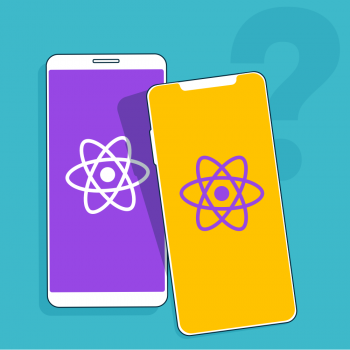React Native, a Javascript framework for IOS and Android applications
Developed by the company Meta (formerly Facebook), React Native is an open-source, hybrid and multi-platform Javascript framework derived from ReactJS. It allows the production of truly native IOS and Android applications, with the same code base and without compromising the experience of your users. The React code (Javascript) is dynamically interpreted at runtime through a bridge to communicate with native APIs while rendering graphical components that are also native.
To put it simply, the hybrid application is the middle ground between a web application and a native application: it is easier, cheaper and faster to develop than a native application and offers more possibilities than a web application. Maintenance is also easier because only one version is managed.
The company Meta uses this framework internally for its mobile applications such as Facebook or Instagram. This technology has also been adopted by Airbnb, Coinbase, Microsoft with Skype and Teams, Discord, UberEats and thousands of other projects.
Benefits and advantages of React Native
Tailor-made
Based on ReactJS, the React Native framework is a recent technology (the first version dates back to March 26, 2015), modern in its approach (state management, declarative approach, etc), which makes it easy to use compared to more dated native solutions. The source code is very similar to the one produced under ReactJS, which allows developers to be compatible between the two solutions
User experience and performance
Unlike solutions based on a simple embedded web view, applications developed with React Native offer an experience very similar to those developed natively, with the elements displayed on the screen resulting from the platform used. This translates into a natural user experience and fast loading times. React Native is quick to install and easy to learn
Cost-effectiveness
A single code base is an opportunity to considerably reduce the time - and by extension the cost - of development compared to a native approach. React Native is therefore less expensive. It also guarantees an identical experience from one platform to another, as the business code is shared throughout the product life cycle
In the context of development, React Native integrates a hot reloading functionality, which allows the developer to observe the result of his modifications without having to recompile the entire source code, which is a significant time saver.
A growing community of developers
As the framework is open source and regularly updated by Meta, its community is growing and is very active on the forums, which provides effective support for our developers
React Native compared to other technologies
React Native is not the only application development tool on the market. In fact, there are several of them and despite its popularity, other software are making a name for themselves. We can compare React Native to these:
Flutter –
Flutter is a free and open-source framework, created by Google, allowing the development of multiplatform applications. Flutter is based on Dart, a fast, object-oriented programming language. This framework also provides its own widgets, taken from its own high performance rendering engine, as well as various additional tools.
Flutter is fast, supports multiple devices, has its own programming language and makes publishing and documentation easy. However, this framework has its limits. Indeed, its programming language is hard to adopt and it is less popular.
Swift –
Swift is a mobile programming language, open-source and native, created by Apple to develop iOS and Mac applications. It has a fast development process, is easily scalable and focuses on speed, performance and security. Memory management is automatic and is compatible with Objective-C. Swift is behind the following applications such as WhatsApp, LinkedIn or Slack.
Only, the main difference between React Native and Swift is that React Native can create cross-platform applications while Swift only creates applications for Apple platforms.
Cordova –
Cordova is an open-source framework that allows you to create hybrid apps for different platforms in HTML, CSS and JavaScript. Cordova is compatible with Android, iOS and several other platforms. This framework has several plugins and only one development is needed to make your application work on different mobile platforms.
Only, the installation of an offline mode is much more difficult to design on cross-platform. Moreover, not all the functionalities of your smartphone can be exploited to the maximum as with a native application.
Our expertise
At Ylly, with several years of experience, we have been able to build an efficient development stack with :
- Typescript language to get a more robust and efficient code,
- The Expo tool to facilitate development, allowing to do without native code,
- The publication on the stores: deployment in OTA "Over The Air" allowing an update integrated into the application, without the user having to go through the store or be connected on his wifi for the updates to be triggered. This is a convenient out-of-store deployment solution.
- The distribution of test applications to the client via a dedicated solution.
With React Native and the powerful tools it offers, Ylly has the possibility to answer more problems and needs of its customers.
The strength of React Native is also the strength of Ylly!
To learn more about our React Native expertise, contact us!








